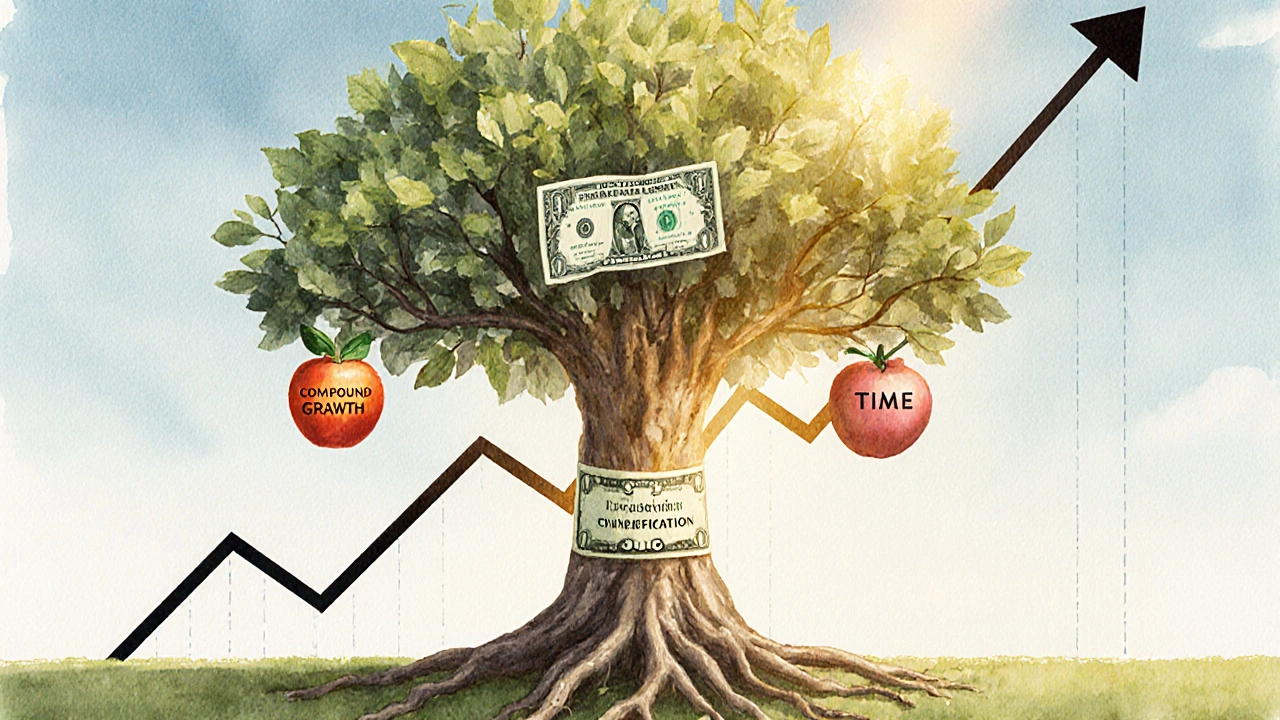Most people think investing is for rich folks with fancy desks and Bloomberg terminals. That’s not true. Investing is the single most powerful tool you have to grow your money-no matter how much you start with. If you’re not investing, you’re losing money every single year. Not because you’re spending too much. Not because you’re not earning enough. But because inflation eats away at cash. The dollar you saved in 2020 is worth about 12% less today. That’s not a theory. That’s the numbers from the U.S. Bureau of Labor Statistics.
Why Cash Is the Worst Investment
Keeping money under the mattress or in a savings account isn’t safe-it’s just slow suicide for your buying power. In 2024, the average savings account interest rate in the U.S. was 0.46%. Meanwhile, inflation was at 3.1%. That means your money lost 2.64% in real value just sitting there. Over 10 years, $10,000 in a savings account would shrink to the equivalent of $7,700 in today’s dollars. Meanwhile, the S&P 500 returned an average of 10.5% annually over the same period. Even after accounting for fees and taxes, you’d end up with nearly $27,000. That’s the power of investing.
People say, “But what if the market crashes?” Sure, it will. The S&P 500 has dropped more than 20% seven times since 1980. But here’s the thing: every single one of those crashes was followed by a recovery-and then a new high. If you held through 2008, you doubled your money by 2013. If you held through March 2020, you were back to even by August. Timing the market is a myth. Staying in the market is the strategy.
How Investing Actually Works
You don’t need to pick stocks like Warren Buffett. You don’t need to day trade or follow TikTok gurus. Investing works because of three simple forces: compound growth, diversification, and time.
Compound growth means your money earns returns, and then those returns earn returns. Put $200 a month into an index fund that returns 8% annually. After 10 years, you’ve put in $24,000. You end up with $36,800. That’s $12,800 in free money from growth. After 20 years? $118,000. After 30? $284,000. That’s not luck. That’s math.
Diversification means not putting all your eggs in one basket. Instead of buying Apple stock alone, you buy a fund that owns Apple, Microsoft, Coca-Cola, Nike, and 500 other companies. That way, if one company fails, the rest carry you. The Vanguard Total Stock Market Index Fund (VTI) holds over 3,700 U.S. companies. You own a piece of Amazon, Tesla, and your local grocery chain-all in one trade.
Time is your secret weapon. The earlier you start, the less you need to save. Someone who starts investing $300 a month at age 25 will have more at 65 than someone who starts at 35 and saves $600 a month. Why? Because of compounding. The first 10 years of investing matter more than the last 10.
Where to Start: Simple, Proven Options
You don’t need a financial advisor to begin. You just need a brokerage account and a plan. Here are the three most effective, low-cost ways to invest right now:
- Index funds - These track the entire market. The S&P 500 index fund (like VOO or SPY) gives you exposure to the 500 biggest U.S. companies. Fees? As low as 0.03% per year. That’s $3 on $10,000. You can’t beat that.
- Target-date funds - These are automatic portfolios that adjust over time. If you’re 30 and plan to retire at 65, a 2060 target-date fund will start with 90% stocks and slowly shift to bonds as you get closer to retirement. Fidelity, Vanguard, and T. Rowe Price offer these with no management fees beyond the fund’s expense ratio.
- Robo-advisors - Platforms like Betterment or Wealthfront ask you a few questions-your age, goals, risk tolerance-and then build and manage a portfolio for you. They charge 0.25% annually. That’s less than your coffee budget.
These aren’t speculative. They’re backed by decades of academic research. The Bogleheads, named after John Bogle, founder of Vanguard, have spent 40 years proving that low-cost, diversified investing beats 90% of professional fund managers.

What Not to Do
There are traps everywhere. Here are the three biggest mistakes people make:
- Chasing hot stocks - GameStop, Bitcoin, Dogecoin-these aren’t investments. They’re gambling with extra steps. You might get lucky once. But over time, the odds always favor the market, not the meme.
- Trying to time the market - Waiting for a “better entry point” means you miss the best days. Between 2000 and 2024, the S&P 500 had its 10 best days all happen within two weeks of its 10 worst days. If you were out of the market during those 10 days, your returns dropped by 50%.
- Ignoring fees - A 1% fee on a $100,000 portfolio costs you $1,000 a year. Over 30 years, that’s over $150,000 in lost growth. Low-cost index funds aren’t just safer-they’re dramatically cheaper.
Real People, Real Results
Meet Maria, 32, a nurse in Chicago. She makes $65,000 a year. She started investing $200 a month in a Vanguard target-date fund in 2021. She didn’t touch it. She didn’t check it every day. She didn’t panic when the market dropped in 2022. In 2025, her account is worth $18,700. She didn’t win the lottery. She didn’t get a raise. She just invested consistently. That’s it.
Or James, 45, a teacher. He had $12,000 in his 401(k) in 2018. He switched from an active fund with 1.2% fees to a low-cost S&P 500 index fund. He increased his contribution from 5% to 10% of his salary. In 2025, his 401(k) is worth $89,000. He’s on track to retire at 60. Not because he’s rich. Because he invested.

Getting Started Today
You don’t need $10,000. You don’t need to wait for “someday.” Here’s your 5-minute action plan:
- Open a brokerage account with Fidelity, Charles Schwab, or Vanguard. All offer $0 commissions and no minimums.
- Set up an automatic transfer of $25, $50, or $100 from your checking account every payday.
- Invest it all in a low-cost index fund like VTI or a target-date fund matching your retirement year.
- Ignore the news. Don’t check your balance more than once a quarter.
- Increase your contribution by 1% every year, or whenever you get a raise.
That’s it. No complex strategies. No stock tips. Just consistent, simple, boring investing. The kind that builds real wealth over decades.
What Happens If You Wait?
Let’s say you’re 30 and you think, “I’ll start investing when I make $100,000.” You wait five years. By then, you’re 35. You start putting away $500 a month. You’ll have $450,000 by 65. But if you’d started at 30 with $300 a month? You’d have $620,000. That’s $170,000 more just because you started five years earlier.
Waiting doesn’t make you smarter. It just makes you poorer.
The best time to invest was 10 years ago. The second best time is today.
Do I need a lot of money to start investing?
No. Many brokerages let you start with $1. You can invest as little as $25 a month in an index fund or target-date fund. The key isn’t how much you start with-it’s that you start and stay consistent.
Is investing risky?
All investments carry risk, but not investing is riskier. Keeping money in cash means losing value to inflation. Diversified index funds reduce risk by spreading it across hundreds of companies. Over 20+ years, the odds of losing money in the S&P 500 are less than 5%.
Should I invest in Bitcoin or crypto?
Crypto is speculative, not an investment. It has no cash flow, no earnings, and no history of long-term growth. If you want to speculate with a small portion of your money, fine-but don’t confuse it with building wealth. Stick to index funds for your core portfolio.
What’s the difference between a 401(k) and a brokerage account?
A 401(k) is a retirement account offered by employers. Contributions are often matched by your employer, and you get tax breaks. A brokerage account is personal-you can buy and sell anytime, but you pay taxes on gains. Use both: max out your 401(k) match first, then invest in a brokerage account.
How often should I check my investments?
Once a quarter is enough. Checking daily or weekly leads to emotional decisions. The market goes up and down every day. What matters is the trend over years. Set it and forget it-until it’s time to rebalance every 1-2 years.
Next Steps
If you’re reading this and thinking, “I don’t have time,” or “I don’t know enough,” that’s exactly why you need to start now. You don’t need to be an expert. You just need to begin. The system works. The math doesn’t lie. And the longer you wait, the harder it gets.
Open that account. Set up that automatic transfer. Let your money work while you sleep. That’s how real financial growth happens-not from luck, not from hustle, but from simple, consistent investing.


